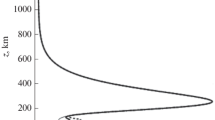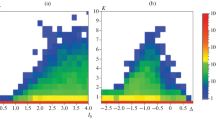Abstract
A THEORY of the interaction of radio waves in the ionosphere, first reported by Tellegen1 in 1933 and afterwards observed by many others, was given by Bailey and Martyn2. According to this theory, the modulation M impressed by the interfering longwave station on the medium wave-length transmission reflected from the ionosphere in the vicinity of the long-wave station is where P is the power, D the depth of modulation and n/2Ï the modulation frequency of the long-wave station. v0 is the collision frequency of an electron in thermal equilibrium with the gas molecules in that portion of the E-layer traversed by the wave of medium wave-length. The quantity G is a constant which relates the mean fractional loss of energy of / of an electron in collisions with molecules of the gas to the collision frequency v in a state of motion where the mean energy of agitation of the electrons slightly exceeds that of the gas molecules.
Similar content being viewed by others
References
Nature, 131, 840 (1933).
Nature, 133, 218 (1934); Phil. Mag., 18, 369 (1934).
Proc. Roy. Soc., A, 88, 336 (1913).
Nature, 135, 585 (1935).
Nature, 139, 68 (1937); Phil. Mag., vii, 23, No. 157 (1937).
Nature, 139, 838 (1937).
Author information
Authors and Affiliations
Rights and permissions
About this article
Cite this article
HUXLEY, L., FOSTER, H. & NEWTON, C. Gyro Interaction of Radio Waves. Nature 159, 300–301 (1947). https://doi.org/10.1038/159300a0
Issue Date:
DOI: https://doi.org/10.1038/159300a0
- Springer Nature Limited
This article is cited by
-
Sull'influenza del campo magnetico terrestre nei fenomeni d'interazione fra onde elettromagnetiche
Annali di Matematica Pura ed Applicata (1968)





